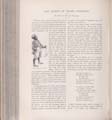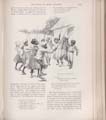
stnic.190309.001.001.jpg
THE SPORTS OF NEGRO CHILDREN
THE little negro girls and boys who live in the towns or on the plantations of the South enjoy their games and sports quite as heartily as do any healthy and hearty girls and boys; but the conditions of their life are not such as to make them acquainted with the sports usually en joyed by other children. If you were to ask one of these curly-haired, black-faced school-children of the South what games he played, he would be very likely to roll the whites of his eyes at you, and his teeth would glisten, while he answered, "Don't play any, sah!" If you should push your inquiries, you might get him to say "Yaas, sah!" to the questions whether he played baseball, tag, and other games. But it is the colored child's misfortune that he cannot reply more fully to such questions. His list of games is really very short. Where children come together, however, as at school, or, once in a very great while at parties and picnics, there is an opportunity for sports which require a number of players.
A rough game, but one of the most popular, is "rap-jacket," which is much played at school. The girls and boys cut long switches, and form two opposite rows, having an equal number of players on each side. The two forces then attack, each trying to make the other give way before the vigorous onslaught of whips. It is "against the rule" to hit in the face, but the blows rain down terrifically on the shoulders of the players; and it is not an unusual sight to see one of them who has been slightly hurt. In spite of the game's roughness, even the girls are very fond of it.
Most of the games which colored children play are "ring" games. These seem to furnish an outlet for the melody in the negro soul, for nearly all are accompanied by singing and dancing. The songs are extremely simple, and of course vary with every game. Very curious rhymes are sometimes thrown together. The tunes in all the games differ very little. To one who for the first time witnesses these musical games, their most striking features are the ease and grace with which most of the players dance and beat time with feet and hands. It is comical to see a circle of these happy little creatures moving hands, feet, and mouths in perfect harmony, and giving rapt attention to the game.
"Hop like de rabbit, ho!" is a favorite ring game. One player enters the circle made by the others, and chooses a partner. In a queer embrace the two clasp each other's shoulders and jump round and round. Meanwhile those in the ring, clapping their hands and beating with their feet, sing these words:
Hop like de rabbit, ho! Hop like de rabbit, ho boy! De rabbit skip, De rabbit hop, De rabbit eat my turnip-top! Hop like de rabbit, ho! Hop like de rabbit, ho boy! De rabbit is a cunnin' thing, He ramble in de dark ; He nebber know what trouble is Till he hear old Rover bark! De rabbit skip, De rabbit hop, De rabbit eat my turnip-top! Hop like de rabbit, ho! Hop like de rabbit, ho boy!
There is another game which is played in the same way, but which requires
different words. It is called "De Willow-tree." I

stnic.190309.001.002.jpggive the words as they were written down for me by a bright little schoolgirl;
but they are a curious jumble. It ought to be said that the songs or chants
given in this article are not [illustration - The game of "rap-jacket."] supposed to be sung, in all parts of the South, or, if sung, they do
not appear in the same form. Their words may differ even in neighboring
localities. The language of a people who depend upon the ear rather than on the
eye for their vocabulary is always changing. The words of "De Willow-tree" are
as follows:
De willow-tree I nebber saw Green grow de willow! Do that again, I'll stick you with a pin, Green grow de willow! De willow-tree I nebber saw, Green grow de willow! Six young ladies, six young gen'lemen, Don't you think it's hard, They hab all got true lover, And I hab none? CHORUS. Rice-cake, rice-cake, rice-cake, Sweet me so! Don't you tell dose girls I love it to my heart! Don't you tell dose boys I eat it, eat it! Don't you tell dose boys I eat it, eat it! To my toe!
Marching and singing are the chief features of the game "Drinking Water." Two of
the players, joining hands above their heads, stand at the apex of an angle
formed by the remaining players, who stand facing away from the first two. The
two at the opposite ends of the columns forming the angle take a few steps
toward each other, being followed in turn by the other players, and, wheeling
half-way

stnic.190309.001.003.jpgaround, march down the center between the
columns and beneath the outspread arms of the first two, who remain in their
places.
Probably the fun in this game is in its soldier-like movements. The song which accompanies the the marching runs thus:
Ho, Nannie! Ho, Nannie! Hand me the gourd to drink water! Drink water, drink water, Hand me the gourd to drink water! Miss Mary, Miss Mary! Hand me the gourd to drink water, Drink water, drink water, Hand me the gourd to drink water!
"Shouting Josephine" is the odd name given to a peculiar game. Two of the players stand inside a ring formed by the others, and the following dialogue ensues between them:
"Josephine!"
"Ma'am?"
"Have you had your breakfast?"
"Yes, ma'am."
"How much?"
"Spoonful."
"Josephine, do you want to shout?"
"Yes, ma'am."
"How long?"
"An hour and a half."
"Then shout, Josephine!"
And so Josephine shouts, as loudly as she can, and, with her hands resting on her hips and her elbows bent, dances gracefully and in perfect time with her lively shouting. Meanwhile the others beat time with their hands. Now and then they cry out, "Finger-ring!" "Ear-right!" "Breast pin!" and so on; and as they mention the words, the shouting Josephine, without stopping her motion, takes her hands from her hips and touches the portion of the body where the ear-ring, breast-pin, and so on, are respectively worn. Josephine shouts and dances as long as she has voice, and then breaks out of the ring, and a compainion takes her place.
The colored children's parties do not differ much in general from those to which
white girls and boys are accustomed. The invited guests come in the
afternoon,—or evening, as

stnic.190309.001.004.jpgSoutherners would
say,—play games, have supper, and go home. In one of the games often
played on such occasions a girl sits under a June-apple tree,—or, if there
happens to be none around, under any small tree or shrub,—and calls a boy
from among the players, who have formed a ring around her. The boy enters the
circle and tries to kiss the girl, who to escape him endeavors to break out of
the ring. But the other players clasp hands and dance round and round, all the
time singing:
Here's Miss Phoebe sits under a June-apple tree, heigh-ho! Seeking for her true-love to see, heigh ho! Here's a young lady sits under my arm; Another sweet kiss will do her no harm! An' another little one, heigh-ho! An' a sweet little one, heigh-ho!
The last two lines are repeated faster and faster, as "Miss Phoebe" makes greater efforts to break the ring: and her compainions circle round with increasing rapidity. When she was at last escaped from her pursuer, the boy who is left chooses another girl from the ring; and then he, in turn, tries to break out before his partner can kiss him.
Then there are birthday parties, to which every invited guest is supposed to bring a present—a cake, a doll, or something of the sort—for the child whose birthday is celebrated. An interesting feature of these parties is the cake-walk. This affords great amusement. The prize cake is put upon a table in the center of the room, while the guests, in couples, walk around the house, in through the door, around the table, and out again. Not far from the cake stands one of the "old folks," who presents a little flag to whichever couples she may choose, as the procession moves past her. The marching in and out of the house continues until a gun is discharged outside; then the two with the flag who happen to be nearest the table are considered the winners of the cake. Besides this prize, however, the successful girl and boy are each allowed to choose one of the presents brought to the host.
Christmas is the greatest holiday among the negroes. It lasts a whole week with them, and during this time some of them seem to think it wrong to do any work. The children believe firmly in the existence of Santa Claus. They hang their stockings beside the fireplace, and[illustration - Hanging up the Christmas stocking.] on Christmas morning imagine that they see his footprints on the hearth. One would think that old St. Nick would leave a great many gifts in such a home, it is so easy for him to climb up and down the chimney; but he does n't leave very many; so it is fortunate that the black children are satisfied with an orange, an apple, a doll, or a stick of candy.